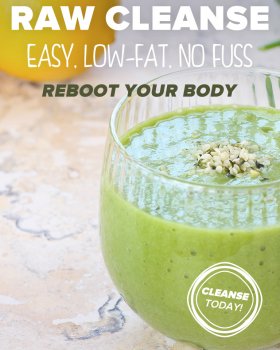-
Rating
Rate me!
Ingredients
1 cup nuts (soaked for 24 hours)
3 cups jicama juice
Recipe Directions
1. Juice enough jicama to make 3 cups of juice.
2. Liquefy jicama juice and soaked nuts in blender.
3. Strain through a cheesecloth or a good tea strainer. Keep the remaining almond pulp for other recipes, such as cinnamon rolls.
4. Pour over cereal, mix in smoothies, or enjoy by itself!
Sweet Adeline's Thoughts
 By Sweet Adeline
By Sweet Adeline A sweet healthy nut milk with no added sweeteners!
it's not water based, for those of you avoiding that nasty deuterium oxide. ;)
This "milk" is very low in saturated fat (depending on the type of nut you use), cholesterol, and sodium. it's also a good source of potassium, and a very good source of dietary fiber and vitamin C.
It has a creamy, white, milky consistency, with just a hint of earth. Makes for an exotic substitute!
Print This Recipe (PDF)
Click the button below to download the printable PDF.
My Notes
You do not have any notes. Add some here. Notes are private and are only visible to you.
Add New NoteHello Beautiful!
It looks like you're new to The Rawtarian Community. If you'd like to get involved, click one of these buttons!
Login to Community Signup for an account Login using FacebookCommunity Recipes
Search Recipes
Community Forum
-

✨Telegram@Active7001 Pirkite padirbtus/buvus eurus internetu Lietuvoje
active11 - 2 min 20 sec ago -

WHATSAPP+12094323659 Pirkite padirbtus pinigus internetu Lietuvoje
active11 - 26 min 40 sec ago -

Telegram@Active7001 Pirkite neapdorotus padirbtus eurus, dolerius, svarus internetu
active11 - 26 min 56 sec ago -

Telgr@m@Active7001 Kaip internetu pirkti padirbtus/buvus pinigus Lietuvoje
active11 - 27 min 32 sec ago -

Tell me where I can find a good casino?
Kercom - 1 hour 18 min ago




























Comments
Top voted
joannabanana
May 06, 2011
i have two questions: how many jicamas do you juice and what do you do with the pulp?? i've never eaten a jicama before. is it a fruit or veggie?
beanybeegan
May 07, 2011
So jicama is a legume. Due to gout problems my DH has stopped eating legumes. Glad we found this out about jicama.
Thanks for the recipe. Most times I use jicama instead of coconut in making cereals and smoothies.
Aubbie
May 06, 2011
This is from wisegeek.com
Jicama is a crispy, sweet, edible root that resembles a turnip in physical appearance, although the plants are not related. Jicama has been cultivated in South America for centuries, and the vegetable is quite popular in Mexican cuisine. Jicama has a unique flavor that lends itself well to salads, salsas, and vegetable platters. The roots can sometimes grow to be quite large, although when they exceed the size of two fists, they begin to convert the sugars that give jicama its sweet flavor into starches, making the root somewhat woody to the taste.
Jicama is actually a legume, and it grows on vines that may reach 20 feet (six meters) in length. The vines tend to hug the ground, terminating in tubers that may grow up to 50 pounds (22 kilograms) in size, although the majority of jicama roots sent to market are approximately three to four pounds (1.3-2 kilograms) in weight. Before eating, the coarse brown outer layer of the jicama should be peeled to reveal the white inside.
When choosing jicama at the store, look for medium sized, firm tubers with dry roots. Do not purchase jicama that has wet or soft spots, which may indicate rot, and don't be drawn to overlarge examples of the tuber, because they may not be as flavorful. Jicama will keep under refrigeration for up to two weeks.
Jicama is excellent raw and is sometimes eaten plain. It can also be used as a substitute for water chestnut in Chinese dishes, in which case it should be thrown in right before serving. Jicama also appears in stews, juiced drinks, stuffings, and a variety of other recipes. In addition to having a unique flavor and texture, jicama takes flavor well, making it well suited to culinary experimentation. Jicama is a great source of vitamin c and is fat free—making it a superb on-the-go snack.
Jicama grows best in warm, dry climates. It can be planted and grown year round, although tubers form better during the winter time. Jicama plants sprouted in the late spring tend to produce extremely robust tubers by the winter, while jicama planted in the summer produces the most flavorful tubers, although they are typically somewhat smaller. Jicama prefers full sun and moderate rainfall, and it is subject to frost damage, making it a poor choice for northern climates. In addition, jicama produces a natural insecticide in the above ground vine, meaning that the plant protects itself from harmful pests.
***
I love jicama and use it mostly in salads. This milk sounds fantastic.
All
sueko
Oct 10, 2011
I love jicama but have never been able to find any organic ones. Where are they grown?
glamazon
May 15, 2011
It sounds so tasty but I can't find any jicama around here. I have been consciously looking too! :(
Sweet Adeline
May 15, 2011
i like almonds the best
Sweet Adeline
May 07, 2011
well, this really depends. at the grocery store i got them from, they were all different sizes, but the first one i juiced was about the size of a grapefruit- maybe a little smaller, and it yielded about 1 2/3 cup juice. it's deffinitely a high-water content veggie. i used my pulp to make a frosting for a cake i was making, but when mixed with some stuff it had the consistency of mashed potatoes, if that inspires you in any way ;)
beanybeegan
May 07, 2011
So jicama is a legume. Due to gout problems my DH has stopped eating legumes. Glad we found this out about jicama.
Thanks for the recipe. Most times I use jicama instead of coconut in making cereals and smoothies.
beanybeegan
May 07, 2011
So jicama is a legume. Due to gout problems my DH has stopped eating legumes. Glad we found this out about jicama.
Thanks for the recipe. Most times I use jicama instead of coconut in making cereals and smoothies.
Aubbie
May 06, 2011
This is from wisegeek.com
Jicama is a crispy, sweet, edible root that resembles a turnip in physical appearance, although the plants are not related. Jicama has been cultivated in South America for centuries, and the vegetable is quite popular in Mexican cuisine. Jicama has a unique flavor that lends itself well to salads, salsas, and vegetable platters. The roots can sometimes grow to be quite large, although when they exceed the size of two fists, they begin to convert the sugars that give jicama its sweet flavor into starches, making the root somewhat woody to the taste.
Jicama is actually a legume, and it grows on vines that may reach 20 feet (six meters) in length. The vines tend to hug the ground, terminating in tubers that may grow up to 50 pounds (22 kilograms) in size, although the majority of jicama roots sent to market are approximately three to four pounds (1.3-2 kilograms) in weight. Before eating, the coarse brown outer layer of the jicama should be peeled to reveal the white inside.
When choosing jicama at the store, look for medium sized, firm tubers with dry roots. Do not purchase jicama that has wet or soft spots, which may indicate rot, and don't be drawn to overlarge examples of the tuber, because they may not be as flavorful. Jicama will keep under refrigeration for up to two weeks.
Jicama is excellent raw and is sometimes eaten plain. It can also be used as a substitute for water chestnut in Chinese dishes, in which case it should be thrown in right before serving. Jicama also appears in stews, juiced drinks, stuffings, and a variety of other recipes. In addition to having a unique flavor and texture, jicama takes flavor well, making it well suited to culinary experimentation. Jicama is a great source of vitamin c and is fat free—making it a superb on-the-go snack.
Jicama grows best in warm, dry climates. It can be planted and grown year round, although tubers form better during the winter time. Jicama plants sprouted in the late spring tend to produce extremely robust tubers by the winter, while jicama planted in the summer produces the most flavorful tubers, although they are typically somewhat smaller. Jicama prefers full sun and moderate rainfall, and it is subject to frost damage, making it a poor choice for northern climates. In addition, jicama produces a natural insecticide in the above ground vine, meaning that the plant protects itself from harmful pests.
***
I love jicama and use it mostly in salads. This milk sounds fantastic.
joannabanana
May 06, 2011
i have two questions: how many jicamas do you juice and what do you do with the pulp?? i've never eaten a jicama before. is it a fruit or veggie?
Leave a Comment